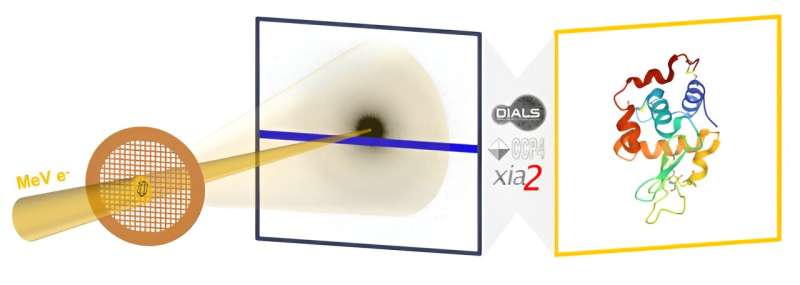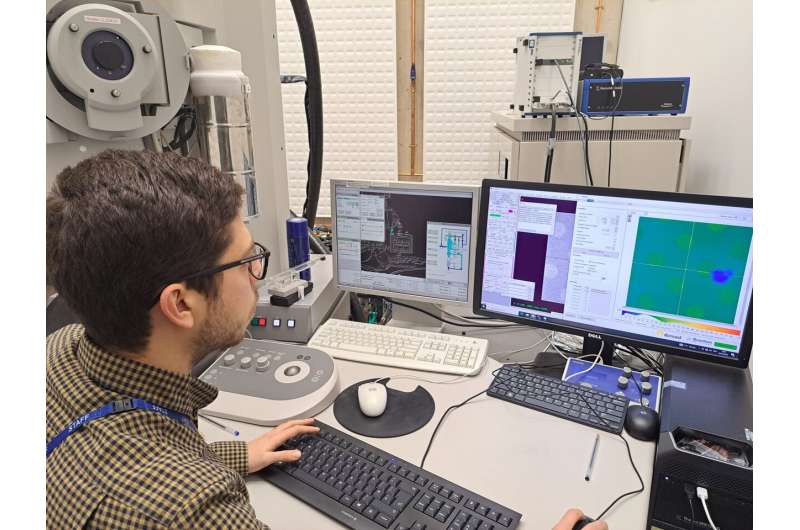This article has been reviewed according to Science X's editorial process and policies. Editors have highlighted the following attributes while ensuring the content's credibility:
fact-checked
trusted source
proofread
Unique high-energy electron Xtallography project completes conceptual design review

A world-first instrument, High-energy electron Xtallography Instrument (HeXI), combining the power of electron diffraction with X-ray beamline expertise is being built by a team at Diamond Light Source, the UK's national synchrotron. On July 20, 2023 they confirmed the successful completion of the conceptual design review for the Mega-electron Volt (MeV), beamline-grade instrument.
Principal Beamline Scientist, Alistair Siebert leading the team says, "This is a significant step towards unlocking the final Technical Design and means we have the go-ahead for this as well as proceeding with the Experimental Hutch design, and the high-energy electron source procurement process. Our overall aim is to to leverage Diamond's expertise in crystallography and instrument design to combine the unique sensitivity of electrons with the outstanding performance of MX goniometry."
The team are now well on the way to building an electron diffraction optimized instrument to enable the use of MeV electrons in structure determination. Their plans bring together a high-performance electron source optimized for nanometer to micron scale crystals with Diamond's extensive experience with beamline design and will enable high-resolution studies of macromolecules and small molecules such as biologics.
Siebert said, "By combining electrons with synchrotron-grade goniometry we hope to provide a truly world-first capability in electron diffraction. What is unique is the application of optimized goniometry for high-speed and high-fidelity data collection, which is currently impossible in conventionally manufactured, commercial transmission electron microscopes."
HeXI will enable highly precise structure determination and the prospect of rapid absolute structure determination of pharmaceutical molecules makes the instrument of particular interest to industry groups.
Anticipated users also include structural biologists who have experience with very small protein crystals developed for time-resolved crystallography at synchrotrons and XFELs. The team also anticipate significant demand from chemistry groups who are keen to investigate rapid synthesis to structure analysis pipelines.
Principle use cases include:
- Rapid, routine and accurate structure determination (charge & enantiomer) of pharmaceutically relevant small molecules
- Determination of macromolecular crystal structures where crystal sizes are inaccessible to both conventional electron microscopes and X-ray methods (~1 µm)
- Electron serial crystallography on macromolecules where crystal sizes are limiting for X-ray work to offer very low-dose structure determinations and potential milli- micro-second time resolution

Pedro Nunes, Beamline Scientist on the HeXI project will be presenting details of the conceptual design at the International Union of Crystallography Research (IUCRJ) in Melbourne, Australia 22–29 August. Alistair Siebert will also be presenting details at IMC20 (International Microscopy Congress) in Korea from 10–15th September.
Pedro joined Diamond from the Centurion group at the University of Lincoln-Nebraska, where he worked in close collaboration with the Stanford Linear Accelerator Center (SLAC) National Laboratory in the development of experimental methodologies for the study of photoinduced molecular dynamics using Mega-electron volt (MeV) Ultrafast Electron Diffraction (UED).
Science Group Leader, David Hall comments that HeXI is a development of the state-of-the-art nano-focus VMXm beamline and the project team works closely with Gwyndaf Evans and his team. "This instrument will occupy a space between our MX and Powder Diffraction beamlines, I19 small molecule crystals and our VMXm beamline which can take very small crystals. We are very excited about the new possibilities this instrument will enable for new and existing users."
Provided by Diamond Light Source





















